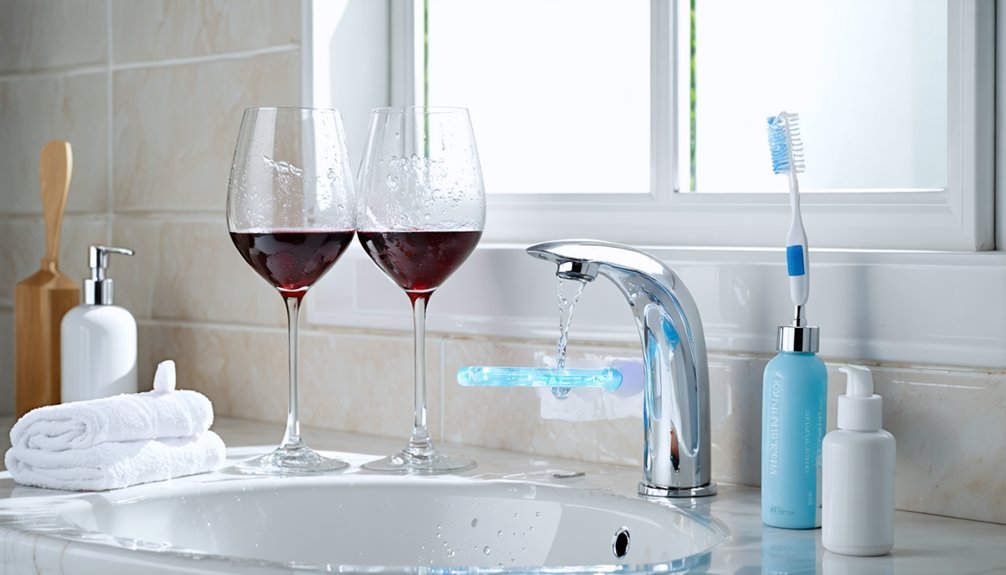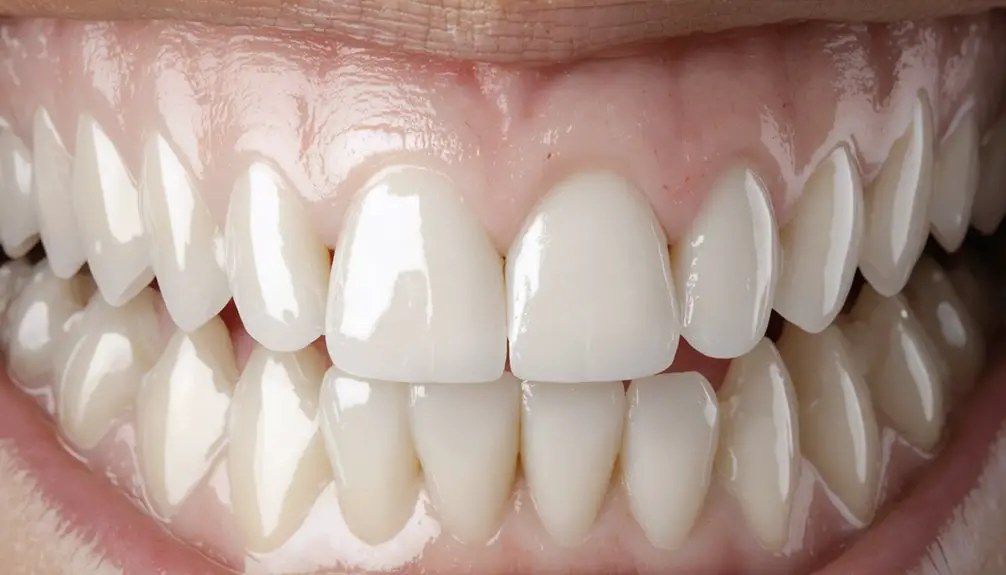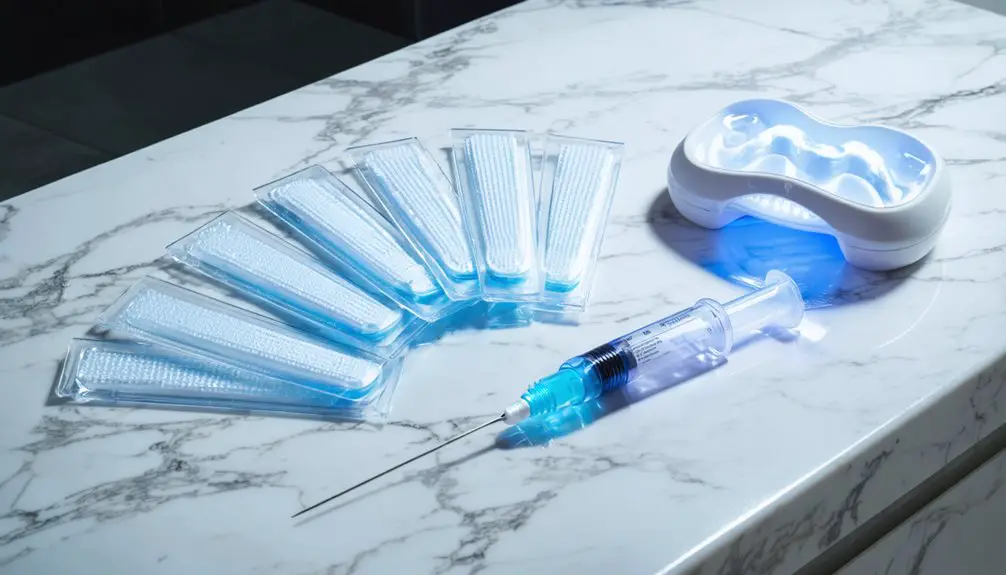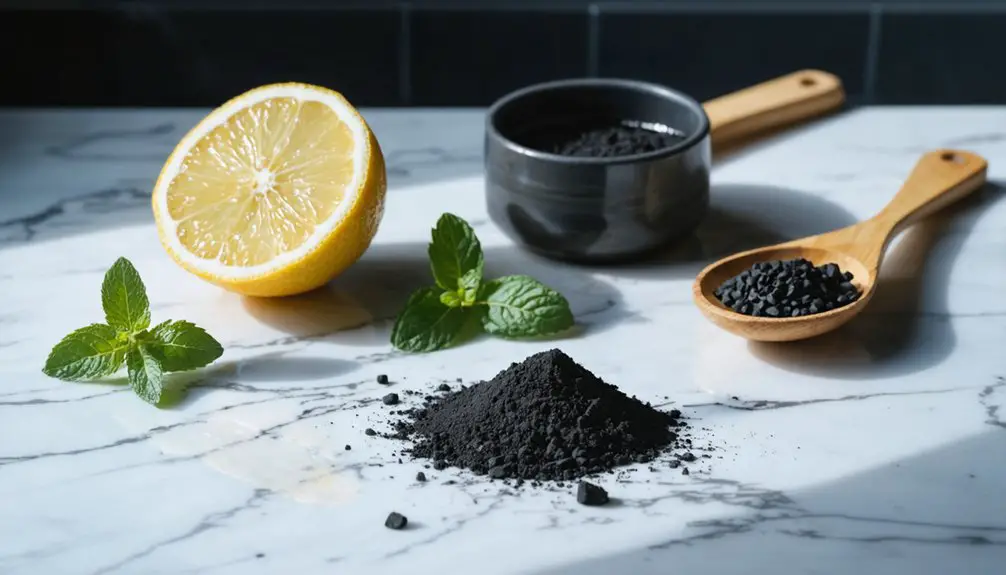Professional teeth whitening treatments using 25-40% hydrogen peroxide provide the strongest defense against wine and food stains. You’ll see the most dramatic results with in-office procedures, which can lighten teeth considerably in a single session under dental supervision. While at-home options like whitening strips and gels offer more affordable alternatives, they require consistent use over several weeks for moderate improvement. Understanding the science behind stain removal can help you make the most effective choice for your situation.
Key Takeaways
- Professional treatments using 25-40% hydrogen peroxide provide the most effective results for removing wine stains but cost over $300.
- At-home whitening strips with LED light devices can lighten teeth up to 3 shades within two weeks.
- Conventional at-home treatments using 20% carbamide peroxide offer superior results compared to paint-on gels and pre-filled trays.
- Products containing PVP, calcium carbonate, and sodium bicarbonate help prevent new stains while removing existing discoloration.
- Regular use of whitening toothpaste combined with proper oral hygiene maintains results and prevents future wine stains.
Understanding Wine and Food Stains on Teeth
When red wine meets your teeth, it initiates a complex interaction of chemical compounds that can lead to significant staining. The wine composition includes anthocyanins, tannins, and acids that work together to create a powerful staining effect.
Anthocyanins provide the deep color, while tannins act as binding agents that help these pigments adhere to your enamel.
The double-action of anthocyanins and tannins creates the perfect storm for wine stains, as color molecules bond firmly to tooth surfaces.
Your teeth’s vulnerability to staining depends on several factors, including enamel strength and plaque presence. The acidic nature of wine temporarily softens your enamel, making it more susceptible to pigment absorption. White wine before red can increase acid exposure and worsen staining effects. Using a straw for drinking can help minimize contact between wine and your teeth’s surface.
Understanding these mechanisms is essential for stain prevention, as frequent exposure to wine and other chromogen-rich foods like coffee, tea, and berries can progressively darken your teeth, especially when combined with acidic substances that compromise enamel integrity.
Types of Teeth Whitening Products and Their Effectiveness
To combat wine and food stains effectively, modern dental science offers various whitening solutions with distinct mechanisms of action.
Whitening strips and dental gels containing hydrogen peroxide or carbamide peroxide can lighten your teeth by up to 3 shades within two weeks, requiring twice-daily applications of 30 minutes each. LED light devices paired with whitening strips can provide enhanced results while maintaining comfort and preventing sensitivity.
For maintenance, sodium bicarbonate-based whitening toothpastes effectively remove surface stains while supporting your primary whitening regimen.
Research shows that conventional at-home whitening with 20% carbamide peroxide achieves superior color change compared to over-the-counter options.
Paint-on gels and pre-filled trays offer convenient at-home options, though they’re less potent than professional treatments.
While whitening rinses provide minimal results due to limited contact time, they’re useful for preventing new stains.
Each product serves a specific purpose in your whitening journey, with strips and gels delivering the most noticeable results for typical wine and food discoloration.
Professional Whitening vs. At-Home Solutions
Choosing between professional teeth whitening and at-home solutions requires careful consideration of several key factors.
Professional whitening treatments use higher concentrations of hydrogen peroxide (25-40%) and can lighten teeth up to eight shades in a single 1-2 hour session, making them particularly effective for stubborn wine and food stains. Most treatments include gum protection measures to prevent tissue damage during the procedure.
While they’re more expensive at $300+, they offer superior results and dental supervision. A dental consultation can help assess oral health and determine the most suitable treatment approach.
At-home solutions, though more affordable at around $50, contain lower peroxide levels (3-10%) and require consistent application over weeks to achieve 3-6 shade improvements.
They’re better suited for mild discoloration or maintenance.
While these solutions offer convenience and accessibility, they’re less effective on deep stains and may need more frequent reapplication.
Your choice should depend on stain severity, budget, and desired timeline for results.
Key Ingredients That Combat Wine and Food Discoloration
Understanding the science behind teeth whitening ingredients helps you select the most effective products for wine and food stains. The most potent ingredients combine peroxide-based whitening agents with stain-fighting compounds like PVP and dicalcium phosphate. Regular use of these products helps combat the effects of wine’s acidic nature on tooth enamel. Consuming beverages like coffee and tea through drinking straws can help minimize staining while enjoying your favorite drinks.
Knowing the chemistry of whitening agents lets you choose products that effectively combat stains through powerful peroxide and compound combinations.
For those seeking natural remedies, sodium bicarbonate and xylitol offer gentler alternatives while maintaining effectiveness.
- Hydrogen peroxide and carbamide peroxide break down complex stain molecules
- PVP actively binds to wine pigments, preventing them from settling into enamel
- Calcium carbonate and dicalcium phosphate provide gentle abrasion while remineralizing teeth
- Sodium bicarbonate neutralizes acids while offering natural stain prevention
These ingredients work synergistically to not only remove existing stains but also protect against future discoloration.
You’ll find them in professional treatments, at-home kits, and specialized toothpaste formulations.
Maintaining White Teeth After Treatment
While achieving a bright smile through whitening treatments marks an important milestone, maintaining those results requires a thorough aftercare strategy.
Your oral hygiene routine should include twice-daily brushing with whitening toothpaste, daily flossing, and regular use of an antibacterial mouthwash. Opt for light-colored sauces when preparing meals to avoid discoloration.
You’ll need to adjust your dietary choices by limiting exposure to staining substances like wine, coffee, and tea, especially during the first 48 hours post-treatment when your enamel is most vulnerable. During this period, stick to white foods only to prevent reversing your whitening results.
Use straws for pigmented beverages and rinse with water after consuming staining foods.
Schedule professional cleanings every six months and discuss touch-up treatments with your dentist to maintain results.
Consider using custom whitening trays for periodic maintenance, as they guarantee even application and maximize the longevity of your bright smile.
Best Practices for Preventing Future Stains
Preventing stains before they develop requires a strategic combination of proactive oral care and mindful consumption habits. Your stain prevention strategy should focus on thorough oral hygiene before wine consumption and smart drinking practices.
Brush and floss thoroughly before drinking wine to remove plaque that can trap staining agents. During consumption, alternate between wine and water to rinse away pigments and acids.
- Start with red wine instead of white to prevent acid-primed enamel from attracting more stains.
- Use straws for pigmented beverages whenever possible.
- Choose fiber-rich foods and hard cheeses to stimulate natural cleaning saliva production.
- Rinse with sparkling water between glasses to loosen tannins before they set.
Keep sugar-free gum handy to maintain saliva flow and implement periodic cleaning breaks during extended wine sessions.
Frequently Asked Questions
Can Whitening Treatments Damage Existing Dental Work Like Crowns or Veneers?
Powerful professional whitening products won’t physically harm your dental restorations, but they can’t lighten them either. You’ll need proper professional cleaning to remove surface stains from crowns or veneers.
How Soon After Dental Procedures Can I Safely Start Teeth Whitening?
You’ll need to wait 1-2 months after extractions and 7-14 days after fillings. Your dental health considerations and healing timeline may vary based on procedure complexity and your overall health status.
Does Drinking White Wine Instead of Red Prevent Teeth Staining?
While white wine won’t directly stain your teeth, it’ll erode your enamel and make teeth more susceptible to future stains from other foods and drinks. You’re better off limiting both types.
Are Natural Whitening Remedies Like Charcoal Effective for Wine Stains?
While charcoal’s effectiveness is mostly anecdotal, you’ll find it removes surface wine stains but can’t match hydrogen peroxide’s 33% deeper whitening power. Natural remedies like charcoal risk damaging your enamel.
Can Certain Medications Affect the Success of Teeth Whitening Treatments?
Yes, many medication types, including tetracyclines and antihypertensives, can greatly impact whitening effectiveness. You’ll need professional assessment since medications can cause resistant stains and alter your oral tissues’ response to treatment.
References
- https://www.goodhousekeeping.com/health-products/g28723133/best-at-home-teeth-whitening-products/
- https://www.drbobsdentalcare.com/will-teeth-whitening-remove-stains/
- https://www.trysnow.com/blogs/news/wine-stains-on-teeth-how-to-remove-and-why-they-form
- https://www.grantdentistryco.com/what-to-eat-after-teeth-whitening/
- https://pmc.ncbi.nlm.nih.gov/articles/PMC4058574/
- https://www.ada.org/resources/ada-library/oral-health-topics/whitening
- https://www.colgate.com/en-us/oral-health/teeth-whitening/how-to-avoid-red-wine-teeth-this-holiday-season
- https://www.rejuv-health.com/cosmetic-dentistry/teeth-whitening-cost/
- https://rutgershealth.org/news/how-prevent-wine-teeth-holiday
- https://www.jamaicaplaindental.com/how-to-prevent-food-stains-on-teeth/



